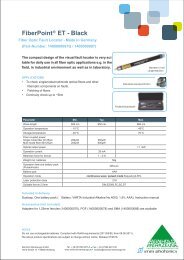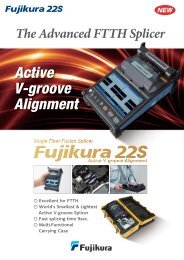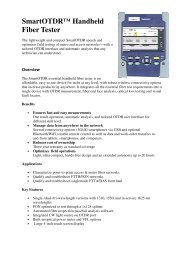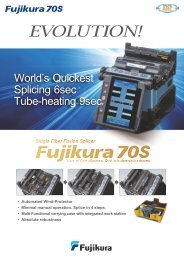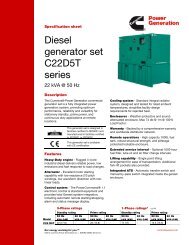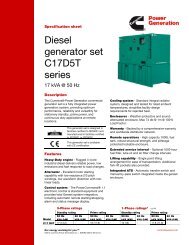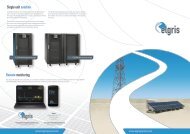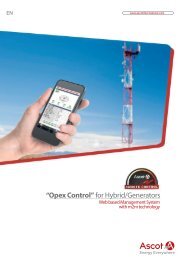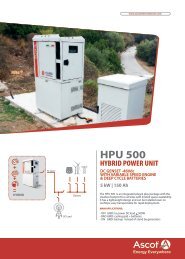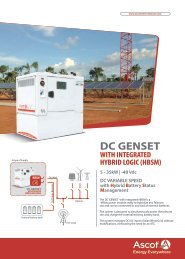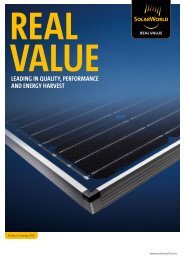EN non sparking tools
You also want an ePaper? Increase the reach of your titles
YUMPU automatically turns print PDFs into web optimized ePapers that Google loves.
NON SPARKING TOOLS<br />
Explosion protection after ATEX = ATmosphere EXplosible<br />
Directive 137 (also known as directive 99/92) determines that the end user (employer) is responsible for the safety of the employees working<br />
(installing, operating or maintaining equipment) in a potentially explosive atmosphere.<br />
The directive has been in force since July 2003.<br />
Classification of the zones by explosion risks<br />
ATEX<br />
Feasibility<br />
high average-low very low<br />
Gases<br />
ZONE 0<br />
is an area, in which dangerous<br />
atmosphere capable of explosion<br />
as a mixture from air and combustible<br />
gases, damping or fogs<br />
exists constantly, for long time or<br />
frequently. The notion „frequently“<br />
is to be used for means of „<br />
temporally mainly „, which means<br />
that explosion-endangered areas<br />
are to be assigned zone 0, if the<br />
atmosphere is capable of explosion<br />
for more than 50% during the<br />
working duration of an arrangement.<br />
Actually, this is only inside<br />
tubes and reservoirs the case.<br />
ZONE 1<br />
is an area in which at normal<br />
working duration, occasionally a<br />
dangerous atmosphere is capable<br />
of explosion as a mixture from air<br />
and combustible gases, damping<br />
or fogs. If the existence of<br />
atmosphere capable of explosion<br />
comes to a duration of approximately<br />
30 minutes per year or this<br />
appears occasionally, e.g. daily,<br />
however, it is smaller than 50% of<br />
the activity duration of the arrangement,<br />
zone 1 applies according<br />
to general opinion.<br />
ZONE 2<br />
is an area in which at normal working duration,<br />
occasionally a dangerous atmosphere<br />
is capable of explosion as a mixture from<br />
air and combustible gas, damping or fogs.<br />
Among a number of experts the general<br />
consensus consists the fact that the<br />
notion corresponds „briefly“ to a duration<br />
of approximately 30 minutes per year.<br />
Furthermore it is stated that atmosphere<br />
capable of explosion is not to be expected<br />
at normal activity usually. If atmosphere<br />
capable of explosion already appears once<br />
a year briefly, the affected area should be<br />
already classified in zone 2.<br />
Dust<br />
ZONE 20<br />
is an area in which dangerous<br />
atmosphere, that is capable of<br />
explosion, exists in form of a<br />
cloud in the air which contains<br />
combustible dust constantly, for<br />
long time or frequently.<br />
ZONE 21<br />
is an area in which at normal<br />
activity occasionally a dangerous<br />
atmosphere capable of explosion<br />
exists in form of a cloud in the air<br />
which contains combustible dust.<br />
ZONE 22<br />
is an area in which at normal activity a<br />
dangerous atmosphere capable of explosion<br />
does not appear in form of a cloud in<br />
the air which contains combustible dust<br />
usually or, however, only briefly.<br />
Application remarks:<br />
• Non <strong>sparking</strong> <strong>tools</strong> are softer than usual <strong>tools</strong>.<br />
The operation with these <strong>tools</strong> has to be carried out with accuracy and care.<br />
Overstraining has to be prevented.<br />
• Only using <strong>non</strong> <strong>sparking</strong> <strong>tools</strong> as a protection measure in fire endangered and explosion endangered areas is<br />
not enough. Please consider the instructions of local health and safety regulations for the protection of employees<br />
and accommodation.<br />
Reworking:<br />
• Technical marking sheets are available on request for reworking (e.g. re-sharpen).<br />
BERYLLIUMplus<br />
Impurity<br />
Matarial<br />
min in %<br />
max in %<br />
Technical properties<br />
Tensile strength<br />
Hardness<br />
Specific weight<br />
Magnetic characteristics<br />
Electrical conduction<br />
Matarial<br />
min in %<br />
max in %<br />
Technical properties<br />
Tensile strength<br />
Yield stress<br />
Hardness<br />
Specific weight<br />
Magnetic characteristics<br />
Electrical conduction<br />
Be<br />
1.8<br />
2.0<br />
Ni+Co<br />
0.2<br />
0.8<br />
0.5<br />
800-940 Mp (average value 850 Mp)<br />
HRC35-42<br />
8,5 (average value)<br />
1.0004<br />
0,53079 S/m<br />
BRONZEplus<br />
Al<br />
9.0<br />
10.0<br />
Ni<br />
4.0<br />
5.0<br />
700-740 Mp (average value 725 Mp)<br />
120 Mp<br />
HRC25-32<br />
7,5 (average value)<br />
1.348<br />
0,42463 S/m<br />
Fe<br />
4.0<br />
5.0<br />
Mn<br />
0.8<br />
2.5<br />
Balance<br />
Cu<br />
Balance<br />
Cu





